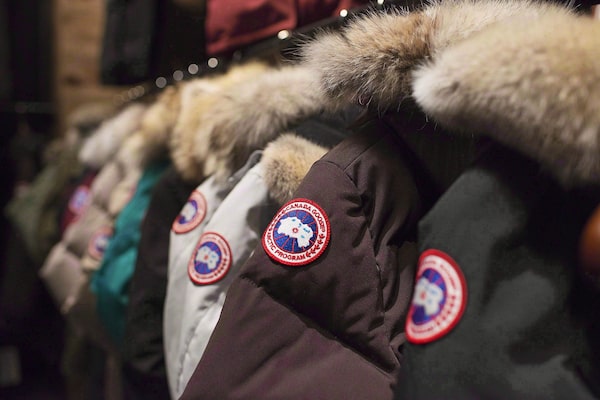
Jackets are on display at a Canada Goose showroom, in Toronto, on Nov. 28, 2013.Aaron Vincent Elkaim/The Canadian Press
In an earnings call this month, executives at Canada Goose said they were expecting a strong holiday season, in spite of the coronavirus pandemic and global supply chain issues, driven in large part by demand for the brand’s luxury parkas in China.
They may have been excited, therefore, to see that on Friday, Canada Goose was the number one topic on social-media platform Weibo, with more than 240 million views on posts about the brand.
Just why Canada Goose was trending, however, will have significantly dampened executives’ spirits, and perhaps their hopes for a China-led surge in purchasing this winter.
Earlier this year, regulators in Shanghai accused Canada Goose of “misleading” advertising, and fined the company’s Chinese affiliate, Xiji Trading Co., 450,000 yuan ($90,000). The regulator cited ads that state all of the down blends in Canada Goose jackets “contain Hutterite down, the best and warmest Canadian down.” China’s advertising law prohibits terms such as “the highest level” or “the best.” The decision also found the claims were misleading, in part because the warmth of down is not directly tied to its origins.
In September, the state-run Economic Daily published a commentary titled “Catching the lying Canada Goose,” which accused the company of failing to understand the country’s advertising laws. The paper said Canada Goose had also “overlooked the changes in the Chinese market” and failed to realize consumers no longer have “blind faith in foreign brands.”
“The moon isn’t rounder in foreign countries, and foreign down jackets aren’t warmer,” the paper said, urging Chinese companies to use the scandal as an opportunity to increase market share.
In a statement, Canada Goose blamed a text error “found on our partner site TMall. As soon as we were made aware it was updated.”
When the scandal broke, some in Canada linked it to continuing tensions between Ottawa and Beijing over the detention of Huawei executive Meng Wanzhou and Canadians Michael Kovrig and Michael Spavor. Other brands have faced boycotts and official censure during periods of geopolitical strife with Beijing.
With Ms. Meng and the Michaels released just weeks after Shanghai regulators fined Xiji Trading, Canada Goose could have been forgiven for thinking the brand might regain its position as top choice for conspicuous Chinese consumption come winter.
Despite selling for upwards of 10,000 yuan ($2,000), Canada Goose jackets are hugely popular in China. The Toronto-based brand operates 14 stores across the Chinese mainland, with three more in Hong Kong and Macao. Its store on TMall, the Alibaba-owned e-commerce platform, recorded sales of 167 million yuan ($33.2-million) in 2020, according to Chinese state media. In a recent statement, Canada Goose said its wider Asia-Pacific business was worth around a quarter of a billion dollars.
With temperatures dropping below freezing across much of northern China, this is prime parka season. This could be why on Friday, the decision by Shanghai regulators against Xiji Trading was recirculating on Weibo, quickly going viral as users noticed “the Canada Goose penalty decision is really a guide to purchasing down jackets.”
In the decision, regulators explain what makes a quality down jacket, from the type of feathers used to stuff the coat, to their “fill power” and “loft,” industry terms that refer to how the down traps air and insulates the wearer. As posts about Canada Goose attracted millions of views, many popular commentators and state-media accounts jumped on the trend, publishing infographics and guides on how to shop for down jackets, many of which are critical of the quality of the Canadian parkas.
“In general, domestic clothing and sports brands, especially some of the smaller brands, have the highest cost performance and are worth buying,” wrote finance blogger He Xi in a widely-shared post. “These brands use the same fabric as international high-end products, and achieve the same warmth retention or heat dissipation rate as international high-end products … but are a lot cheaper.”
Mr. He compared such brands to Huawei, Xiaomi and other Chinese tech companies whose high quality, cut price handsets helped break the dominance of foreign brands such as Apple over China’s smartphone market in the 2010s.
“Canada Goose’s cost performance is the lowest among all brands,” he added. “It’s not too much to say that the price of its clothes is just an IQ tax.”
Other commenters noted that in the past Chinese people had placed high value on foreign brands, but this was changing owing to scandals like that involving Canada Goose, as well as improvements in the quality of domestic Chinese brands.
The Canada Goose statement said the company was “grateful that customers in China and around the world trust us as an authentic brand, and we have seen that reflected in the continued growth of our business.”
The statement added that growth had been “particularly strong in mainland China,” with more than 85-per-cent growth in direct-to-consumer sales in the last quarter.
Alexandra Li contributed to this report.
Our Morning Update and Evening Update newsletters are written by Globe editors, giving you a concise summary of the day’s most important headlines. Sign up today.